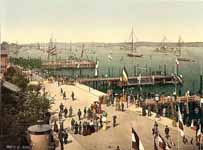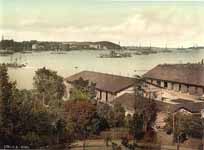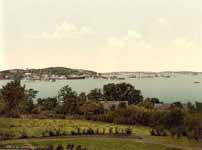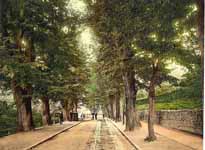Kiel, Images (original) (raw)
.




4, 5, 6,
7, 8, 9, 10, 11,
Kiel
Kiel (German pronunciation: [ˈkiːl]) is the capital and most populous city in the northern German state of Schleswig-Holstein, with a population of 238,049 (2010).
Kiel is approximately 90 kilometres (56 mi) north of Hamburg. Due to its geographic location in the north of Germany, the southeast of the Jutland peninsula, and the southwestern shore of the Baltic Sea, Kiel has become one of the major maritime centres of Germany. For instance, the city is known for a variety of international sailing events, including the annual Kiel Week, which is the biggest sailing event in the world. The Olympic sailing competitions of the 1936 and the 1972 Summer Olympics were held in Kiel.[2]
Kiel has also been one of the traditional homes of the German Navy's Baltic fleet, and continues to be a major high-tech shipbuilding centre. Located in Kiel is the Leibniz Institute of Marine Sciences (IFM-GEOMAR) at the University of Kiel. Kiel is an important sea transport hub, thanks to its location at the Kiel Fjord (Kieler Förde) and the busiest artificial waterway in the world, Kiel Canal (Nord-Ostsee-Kanal). A number of passenger ferries to Sweden, Norway and other countries operate from here. Moreover, today Kiel harbour is an important port of call for cruise ships touring the Baltic Sea.
In 2005 Kiel's GDP per capita was €35,618, well above Germany's national average, and 159% of the European Union's average.[3]
Within Germany and parts of Europe, the city is known for its leading handball team, THW Kiel. The city is home to the University of Kiel (established in 1665).
History
Middle Ages
Kiel Fjord was probably first settled by Normans or Vikings who wanted to colonize the land which they had raided, and for many years they settled in German villages. This is evidenced by the geography and architecture of the fjord. The city of Kiel was originally founded in 1233 as Holstenstadt tom Kyle by Count Adolf IV of Holstein, and granted Lübeck city rights in 1242 by Adolf's eldest son, John I of Schauenburg. Being a part of Holstein, Kiel belonged to the Holy Roman Empire and was situated only a few miles south of the Danish border.[4]
Kiel, the capital of the county (later duchy) of Holstein, was a member of the Hanseatic League from 1284 until it was expelled in 1518 for harbouring pirates. In 1431, the Kieler Umschlag (trade fair) was first held, which became the central market for goods and money in Schleswig-Holstein, until it began to lose significance from 1850 on, being held for the last time in 1900, until recently, when it has been restarted.
Modern times
The University of Kiel was founded on 29 September 1665, by Christian Albert, Duke of Holstein-Gottorp. A number of important scholars, including Theodor Mommsen and Max Planck, studied or taught there.
The port and Kiel Fjord.
Kiel Opera House
From 1773 to 1864, the town belonged to the King of Denmark. However, because the king ruled Holstein as a fief of the Holy Roman Empire only through a personal union, the town was not incorporated as part of Denmark proper. Thus Kiel belonged to Germany, but it was ruled by the Danish king. Even though the Empire was abolished in 1806, the Danish king continued to rule Kiel only through his position as Duke of Holstein, which became a member of the German Confederation in 1815. When Schleswig and Holstein rebelled against Denmark in 1848 (the First Schleswig War), Kiel became the capital of Schleswig-Holstein until the Danish victory in 1852.
During the Second Schleswig War in 1864, Kiel and the rest of Schleswig and Holstein were conquered by a German Confederation alliance of the Austrian Empire and the Kingdom of Prussia. After the war, Kiel was briefly administered by both the Austrians and the Prussians, but the Austro-Prussian War in 1866 led to the annexation of Kiel by Prussia in 1867. On 24 March 1865 King William I based Prussia's Baltic Sea fleet in Kiel instead of Danzig (Gdańsk).
When William I of Prussia became Emperor William I of the German Empire in 1871, he designated Kiel and Wilhelmshaven as Reichskriegshäfen ("Imperial War Harbours"). The prestigious Yacht Club of Kiel was established in 1887 with Prince Henry of Prussia as its patron. Emperor Wilhelm II became its commodore in 1891.
Because of its new role as Germany's main naval base, Kiel very quickly increased in size in the following years, from 18,770 in 1864 to about 200,000 in 1910. Much of the old town centre and other surroundings were levelled and redeveloped to provide for the growing city. The Kiel tramway network, opened in 1881, had been enlarged to 10 lines, with a total route length of 40 km (25 mi), before the end of World War I.
Kiel was the site of the sailors' mutiny which sparked the German Revolution in late 1918. Just before the end of World War I, the German fleet stationed at Kiel was ordered to be sent out on a last great battle with the Royal Navy. The sailors, who thought of this as a suicide mission which would have no effect on the outcome of the war, decided they had nothing to lose and refused to leave the safety of the port. The sailors' actions and the lack of response of the government to them, fuelled by an increasingly critical view of the Kaiser, sparked a revolution which caused the abolition of the monarchy and the creation of the Weimar Republic.
During World War II, Kiel remained one of the major naval bases and shipbuilding centres of the German Reich. There was also slave labour for the local industry.[5] Because of its status as a naval port and as production site for submarines, Kiel was heavily bombed by the Allies during World War II. The bombing destroyed more than 80% of the remaining old town, 72% of the central residential areas, and 83% of the industrial areas.[6] During the RAF bombing of 23/24 July 1944, Luftwaffe fighters tried to intercept the spoof (i.e. decoy) force instead of the main force attacking Kiel,[7] and there was no water for three days; trains and buses did not run for eight days and there was no gas available for cooking for three weeks.[8] The town, its port, the canal and its scientists were seized by the British T-Force under Tony Hibbert just after the German surrender to the western Allies to stop them and access to Denmark falling into Soviet hands, despite it being beyond the stop-line set by the surrender.
Just like other heavily bombed German cities, the city was rebuilt after the war. In 1946, Kiel was named the seat of government for Schleswig-Holstein, and it officially became the state's capital in 1952.
Today, Kiel is once again an important maritime centre of Germany, with high-tech shipbuilding, submarine construction and one of the three leading institutions in the field of marine sciences in Europe, the IFM-GEOMAR. Regular ferries to Scandinavia and Russia, as well as the largest sailing event in the world called the Kiel Week (Kieler Woche) in German and The Kiel Regatta in English. The Kieler Umschlag is another festival, which has been taking place again since 1975. Kiel is also home to a large service sector and a number of research institutions including the University of Kiel, which is the oldest, largest, and most prestigious university in the state.
Main sights
Geistkämpfer in front of the Nikolaikirche, by Ernst Barlach
The Kiel Opera House (Opernhaus Kiel) and the City Hall (Kieler Rathaus).
Historic ships are part of the annual Kiel Week, which is the largest sailing event in the world.
The oldest building in the city is the 13th century Nikolaikirche (St Nicholas' Church), which has a sculpture of Ernst Barlach in front of it called Geistkämpfer.
Kiel is Schleswig-Holstein's largest city, and therefore Kiel's shopping district is a major attraction, and will see further improvement and renovation efforts in the upcoming years. Kiel's Holstenstrasse (Holsten Street) is one of the longest shopping miles in Germany. The Rathaus (town hall), which was built in 1911, has an operating paternoster and the design of its tower was based on one in Venice. The square in front of it is bordered by a lake and the Opera House. There are also a number of lakes and parks in the city centre, e.g. Schrevenpark (Schreven Park). There are two botanical gardens, the Old Botanical Garden and New Botanical Garden.
As Kiel is situated near the sea, the beaches to the north of Kiel such as Kiel-Strande, Kiel-Schilksee, Möltenort and Laboe are also popular places to visit in spring and summer.
Kiel Week, more properly known in English as the Kiel Regatta, is the largest sailing event in the world and takes place in the last week in every June. Many thousands of boats and ships of all kinds and eras take part in the parade. Kiel Week is also a festival, Volksfest and fair as well as a maritime event.
There are a number of sports venues in Kiel, most notably the Sparkassen-Arena (formerly known as Baltic Sea Hall or Ostseehalle), which is the home ground of one of the most successful team handball clubs in the world and multiple German champion, THW Kiel. There is currently no Bundesliga football club in Kiel, but Holstein Kiel plays at Holstein-Stadion. There are a number of yachting and sailing clubs in picturesque settings.
Kiel also features a number of museums, including zoological, geological, historical, fine art, industrial, and military museums. Notable is the Stadtmuseum (City Museum) in Warleberger Hof, which in addition to preserving architecture from the 16th Century and historic rooms with painted stucco ceilings, displays urban and cultural exhibits of the 19th and 20th Century.[9] Particularly intriguing is the history of the carnival in Kiel.[9] Laboe is home to the Laboe Naval Memorial, as well as the World War II submarine U 995, which are popular tourist sites.
Economy
The Holstenstraße is one of the longest shopping streets in Germany — Kiel is the largest city in the state of Schleswig-Holstein.
Kiel's economy is dominated by the service sector, transport and maritime industries. Kiel is also one of the major ports of the German Navy, and a leading centre of German high-tech military and civil shipbuilding. Kiel is the home of Howaldtswerke-Deutsche Werft, a shipyard founded in 1838 famed for its construction of submarines. HDW built the first German submarine Brandtaucher in 1850, and is today a subsidiary of ThyssenKrupp Marine Systems, the leading German group of shipyards.
In 2005, the GDP per person was €35,618, which is well above the national average of Germany and 159% of the European Union average.[3]
2005 EUROSTAT[10] Nominal GDP per capita
Wappen Kiel.svg Kiel €35,618
Schleswig-Holstein €24,250
Germany €27,219
EU27 €22,400
Districts
The city districts of Düsternbrook, Schreventeich, Ravensberg, and Blücherplatz are popular places to live with many 19th century buildings, villas, and tree-lined streets. The government offices, ministries and parliament of the state of Schleswig-Holstein are also mainly based in these neighbourhoods, particularly Düsternbrook. In contrast to the heavy bomb damage inflicted on the central parts of the city during World War II, most of the residential areas were not severely damaged. Hence, Kiel's more modern-style inner city and Kiel's more historic/elaborate residential areas stand in architectural contrast to one another.
There are plans for large-scale improvement and building efforts for the inner city, providing better pavements, better access to and view of the waterfront and a generally more attractive feel to the place. However, these plans have yet to be implemented in coming years.
Transport
Kiel is situated near an important pan-European motorway, the A 7, which connects northern Europe with central and southern Europe.
Kiel has a central station with hourly trains to Hamburg, Lübeck, Flensburg and to Husum. Moreover, the Intercity Express (ICE) connects Kiel with Berlin, Frankfurt, Cologne and Munich.
Kiel is a significant port for passenger and cargo shipping from Germany to Scandinavia, the Baltic States, and Russia. Passenger ferries operate from and to Gothenburg in Sweden (Stena Line, 13½ hours, daily), Oslo in Norway (Color Line, 19½ hours, daily), and Klaipėda in Lithuania (DFDS Lisco, 21 hours, 6 times per week). Cargo ferries operate from and to Saint Petersburg in Russia (DFDS Lisco, twice a week), and Kaliningrad in Russia (NSA, once a week).
The nearest international airport is Hamburg Airport, which is situated approximately 90 kilometres (56 mi) to the south of Kiel. There is a shuttle bus service (KIELIUS) operating between Hamburg Airport and Kiel central station.
Notable people
Peter III of Russia (1728–1762)
Max Planck (1858–1947), physicist
Tomma Abts (b. 1967), painter and Turner Prize winner
Eric Braeden (b. 1941), actor
Alfred Brinckmann (1891–1967), chessmaster
Ernst Busch (1900–1980), actor, writer & collector of songs
Britta Carlson (b. 1978), footballer
Francisco Copado (b. 1974), footballer
Heinrich Dahlinger (1922–2008), Fieldhandball player
Kim Dotcom (b. 1974), Internet businessman
Bruno Diekmann (1897–1982), politician
Cora E. (Sylvia Macco) (b. 1968), musician
Thilo Martinho (Thilo Herrmann) (b. 1960), musician
Michael F. Feldkamp (b. 1962), historian
Heinrich Heesch (1906–1995), mathematician
Rudolf Hell (1901–2002), inventor
Heike Henkel (b. 1964), athlete
Johannes Wolfgang Willy Friedlieb Heuer (1910–1993), businessman
August Howaldt, founder of Howaldtswerke
Sigrid Hunke (1913–1999), author
Otto Kretschmer, U-boat commander
Oswalt Kolle (1928–2010), author
Andreas Köpke (b. 1962), footballer
August Leskien (1840–1916), linguist
Henri Lehmann (1814–1882), painter
Helmut Lemke (1907–1990), politician
Marina Lewycka (b. 1946), author
Detlev von Liliencron (1844–1909), poetrist
Carl Loewe (1796–1869), composer
Judith Malina (b. 1926) in Kiel, co-director and founder of the Living Theatre in the United States, American actress
Hermann Michel (b. 1912), SS officer
Peter III of Russia (1728–1762)
Max Planck (1858–1947), physicist
Heinz Reincke (1925–2011), actor
Karl Leonhard Reinhold, philosopher
Sidney Sam (b. 1988), footballer
Harro Schulze-Boysen (1909–1942), Resistance fighter
Ernst von Salomon (1902–1972), writer
Ulrich Schnauss (b. 1977), musician
Manfred Stahnke (b. 1951), composer
Ernst Steinitz (1871–1928), mathematician
Gerhard Stoltenberg (1928–2001) politician
Johannes Nikolaus Tetens, philosopher
Ferdinand Tönnies (1855–1936), sociologist, philosopher
Carl Friedrich von Weizsäcker (1912–2007), physicist, philosopher
Feridun Zaimoglu (b. 1964), author and playwright
Heiner Zieschang (1936–2004), mathematician
Carl Zuckmayer (1896–1977), writer and playwright
Dieter Laser, Actor
Sister towns
Kiel is twinned with:[11]
France Brest, France (1964)
United Kingdom Coventry, United Kingdom (1947)
Poland Gdynia, Poland (1985)
Russia Kaliningrad, Russia (1992)
Russia Sovetsk, Russia (1992)
Germany Stralsund, Germany (1987 — at that time in East Germany)
Estonia Tallinn, Estonia (1986 — at that time in the Soviet Union)
Finland Vaasa, Finland (1967)
See also
Kiel, Wisconsin
Steenbek-Projensdorf
References
^ "Statistikamt Nord: Bevölkerung in Schleswig-Holstein am 31. Dezember 2010 nach Kreisen, Ämtern, amtsfreien Gemeinden und Städten" (in German). Statistisches Amt für Hamburg und Schleswig-Holstein. 21 July 2011.
^ "General Information". Kieler Woche. Archived from the original on 2005-12-30. Retrieved 2006-03-13.
^ a b GDP per person 2005 in Euro
^ "A brief history of Kiel". Kiel - a portrait of the city. City of Kiel. Retrieved 2007-07-01.
^ Victor, Edward. "Alphabetical List of Camps, Subcamps and Other Camps". Retrieved July 25, 2008.
^ "The Navy changed the face of Kiel". Kiel — a portrait of the city. City of Kiel. Retrieved July 25, 2008.
^ Jones, R. V. (1978). Most Secret War: British Scientific Intelligence 1939-1945. London: Hamish Hamilton. p. 466. ISBN 0 241 89746 7.
^ Campaign Diary: July 44, Royal Air Force Bomber Command 60th Anniversary site. Accessed 4 May 2007
^ a b "Kieler Stadtmuseum Warleberger Hof", City of Kiel webpage, in German
^ "Regional GDP per inhabitant in the EU 27" (PDF). Eurostat. Retrieved 2008-08-19.
^ www.kiel.de Twin cities of Kiel (in German)
From Wikipedia, All text is available under the terms of the GNU Free Documentation License